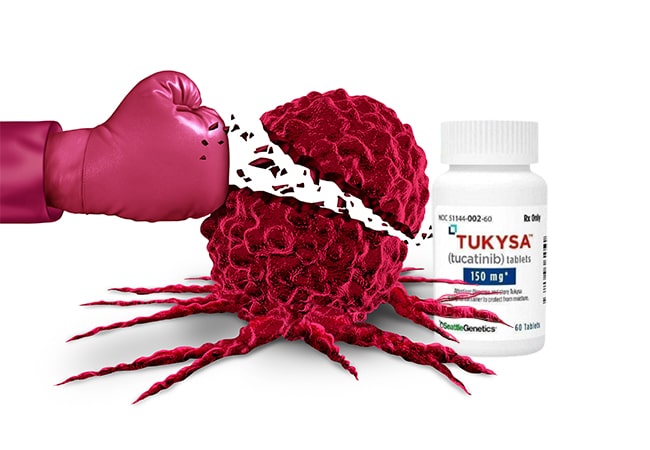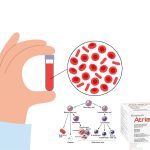Cancer treatments have come a long way, and one of the exciting advances in recent years is Tukysa (tucatinib). Approved by the FDA, Tukysa is making waves in the treatment of HER2-positive breast cancer, particularly for patients whose cancer has spread to other parts of the body, including the brain. But how does Tukysa work? Let’s evaluate its mechanism of action in an easy-to-understand way.
Targeting HER2: The Basics:
To grasp how Tukysa works, it’s essential to understand what HER2 is. HER2 stands for Human Epidermal growth factor Receptor 2, a protein that promotes the growth of cancer cells. In some breast cancers, there’s an overexpression of HER2, meaning too much of this protein is present on the surface of cancer cells. This overabundance makes these cancer cells grow and divide more rapidly than normal cells.
Tukysa’s Role: A Precision Strike
Tukysa is a type of drug known as a tyrosine kinase inhibitor (TKI). Tyrosine kinases are enzymes that act like switches, turning on or off various cellular functions, including cell division and growth. In HER2-positive cancer cells, these switches are stuck in the “on” position, leading to uncontrolled growth. Tukysa works by inhibiting (blocking) these tyrosine kinases specifically associated with the HER2 receptor.
Crossing the Blood-Brain Barrier:
One of the standout features of Tukysa is its ability to cross the blood-brain barrier. This barrier is a protective shield that keeps many substances in the bloodstream from reaching the brain. While this is beneficial for protecting the brain from toxins, it also makes treating brain metastases challenging. Tukysa’s ability to penetrate this barrier means it can target and treat cancer cells that have spread to the brain, offering hope for patients with brain metastases from HER2-positive breast cancer.
Combination Therapy: Enhancing Efficacy
Tukysa is often used in combination with other cancer drugs, such as trastuzumab and capecitabine. Trastuzumab, another HER2-targeted therapy, binds to the HER2 receptors on the outside of cancer cells, while capecitabine is a chemotherapy drug that interferes with the DNA synthesis of cancer cells. By combining these treatments, Tukysa enhances the overall effectiveness, attacking cancer cells through multiple mechanisms. This combination approach not only targets the HER2 receptor from different angles but also helps to slow down the cancer’s ability to develop resistance to treatment.
A Ray of Hope in Oncology:
Tukysa represents a significant advancement in the fight against HER2-positive breast cancer, especially for those with metastatic disease. Its ability to specifically target cancer cells, cross the blood-brain barrier, and work synergistically with other treatments makes it a powerful tool in oncologists’ arsenals.
In conclusion, Tukysa’s mechanism of action revolves around its precision targeting of HER2-positive cancer cells and its ability to work in conjunction with other therapies to provide a more comprehensive attack on the disease. For patients battling this aggressive form of cancer, Tukysa offers a ray of hope, combining cutting-edge science with tangible results.
Reference:
https://global.tukysa.com/
https://www.ncbi.nlm.nih.gov/books/NBK595370/
https://www.cancer.gov/news-events/cancer-currents-blog/2020/tucatinib-trastuzumab-deruxtecan-her2-positive-metastatic-breast-cancer
What are the key benefits of Tukysa in cancer treatment?
Tukysa accurately targets HER2+ cancer cells, crosses the blood-brain barrier to treat brain metastases, and works synergistically with other therapeutic drugs like trastuzumab and capecitabine for improved outcomes.
What are the common side effects of Tukysa?
Common side effects include vomiting, diarrhea, nausea, fatigue, and changes in liver enzymes. Always consult your doctor for advice on managing side effects and understanding Tukysa’s suitability for your condition.
How can I buy Tukysa online in India?
Indian Pharma Network (IPN) facilitates the supply of imported medicines, including Tukysa. You can buy Tukysa online in India or contact us for delivery to cities like Delhi, Mumbai, Hyderabad, Chennai, Kolkata, Pune, Lucknow, Noida, Jaipur, Ahmedabad, and more. Kindly Call/WhatsApp: +91 9310090915 for more information.
Where can I find Tukysa in Delhi, Lucknow, and other cities?
Tukysa is available through the Indian Pharma Network (IPN). We ensure delivery to leading hospitals and patients in Delhi, Lucknow, Noida, Chennai, Bangalore, Hyderabad, Mumbai, Pune, Ahmedabad, Kolkata, and other cities across India.
Where can I buy Tukysa?
Tukysa (tucatinib) is available through trusted suppliers like the Indian Pharma Network (IPN). We help facilitate the legal supply of imported medicines. You can buy Tukysa and have it delivered to leading hospitals /institutions or directly to patients across India, including Delhi, Mumbai, Hyderabad, Chennai, Bangalore, Kolkata, Lucknow, Noida, Pune, Jaipur, and Ahmedabad.






